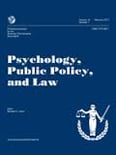When asked ‘do you know’ and ‘do you remember’ (DYK/R) questions containing an implicit wh- (who, what, where, why, how, and which) question requesting information, children often provided unelaborated ‘yes’ responses. When DYK/R questions contained an implicit yes/no question, unelaborated ‘yes’ or ‘no’ responses could be responding to the explicit or implicit questions resulting in referentially ambiguous responses. In the context of testimony during child sexual abuse cases, children often provided referentially ambiguous responses, and attorneys usually failed to disambiguate children’s answers. This is the bottom line of a recently published article in Psychology, Public Policy, and Law. Below is a summary of the research and findings as well as a translation of this research into practice.

Featured Article | Psychology, Public Policy, and Law | 2017, Vol. 23, No. 2, 191-199
Pragmatic Failure and Referential Ambiguity When Attorneys Ask Child Witnesses “Do You Know/Remember” Questions
Authors
Angela D. Evans, Brock University
Stacia N. Stolzenberg, Arizona State University, Tempe
Thomas D. Lyon, University of Southern California
Abstract
“Do you know” and “Do you remember” (DYK/R) questions explicitly ask whether one knows or remembers some information while implicitly asking for that information. This study examined how 4-to 9-year-old (N=104) children testifying in child sexual abuse cases responded to DYK/R wh- (who, what, where, why, how, and which) and yes/no questions. When asked DYK/R questions containing an implicit wh- question requesting information, children often provided unelaborated “yes’ responses. When DYK/R questions contained an implicit yes/no question, unelaborated “yes’ or “no” responses could be responding to the explicit or the implicit questions resulting in referentially ambiguous responses. Children often provided referentially ambiguous responses and attorneys usually failed to disambiguate children’s answers. Although pragmatic failure following DYK/R wh- questions decreased with age, the likelihood of referential ambiguity following DYK/R yes/no questions did not. The results highlight the risks of serious miscommunication caused by pragmatic misunderstanding and referential ambiguity when children testify.
Keywords
Child witnesses, pragmatics, referential ambiguity, testimony
Summary of the Research
“Children’s difficulty in understanding the implied meaning of questions can led to miscommunication…and both adults and children can fail to recognize the ambiguity of children’s answers. This study examined one way in which child witnesses’ failure to understand the implied meaning of questions may lead to miscommunication and ambiguity. We identified ‘Do you know’ and ‘Do you remember’ (DYK/R) questions asked of child witnesses that explicitly asked whether children knew or remembered information while implicitly asking for that information. We distinguished between DYK/R wh- questions, which could lead to incomplete responding, and DYK/R yes/no questions, which could lead to ambiguous responding (p.191).”
“We suspect that both children and attorneys have only limited awareness of the referentially ambiguous nature of DYK/R questions containing implicit yes/no questions. The ambiguity of an unelaborated ‘yes’ or ‘no’ response is subtle because one has to generate the alternative interpretations to identify the ambiguity. For example, if a child is asked, ‘Do you remember if it was dark?’ and answers ‘No,’ the attorney must mentally generate ‘No, I don’t remember’ and ‘No, it wasn’t dark’ to recognize the ambiguity (p.193).”
“This study examined the use of DYK/R questions in sexual abuse trials in which child witnesses testified. We first looked for evidence of pragmatic failure by determining whether children often gave unelaborated ‘yes’ responses to DYK/R questions that implicitly asked wh- questions (e.g., ‘Do you remember where it happened?’). We examined how attorneys responded to such answers to ascertain whether the questions were indeed intended to ask both a literal and an implied question. We predicted that children would frequently exhibit pragmatic failure but that this tendency would diminish with age (p.193).”
“We then turned to DYK/R questions that implicitly asked yes/no questions. With respect to DYK/R if/whether questions (e.g., ‘Do you remember if it was dark?’), we examined the extent to which children gave unelaborated ‘yes’ and ‘no’ responses. With respect to DYK/R questions gerund questions (e.g., ‘Do you remember going to the house?’), we examined how often children simply said ‘No.’ We then determined whether attorneys sought to disambiguate children’s responses…We predicted that children would frequently provide referentially ambiguous responses, and that this tendency would diminish with age. We anticipated that attorneys would frequently fail to clarify whether children were answering the explicit or literal question (p.193).”
“We found that in 18% of the cases in which attorneys asked DYK/R questions containing an implicit wh- question, there was clear evidence that pragmatic failure occurred; children responded with an unelaborated ‘yes,’ and attorneys followed up by asking the implicit question…We found that children provided referentially ambiguous responses to about half of the DYK/R if/whether questions and about a fourth of the DYK/R gerund questions. Attorneys usually failed to disambiguate children’s responses. As a result, 22-37% of the DYK/R yes/no questions led to unresolved referential ambiguity. When attorneys did seek clarification, children revealed that they had been answering the literal question about half the time and implicit question about half the time. Hence, there is substantial opportunity for misunderstanding children’s responses because of the use of DYK/R questions (p. 196-197).”
“Consistent with our prediction, children were less likely to exhibit pragmatic failure as they grew older, and more likely to answer the implicit question, suggesting that development plays a part in children’s interpretation of indirect speech acts. However, children exhibited no age improvement in the likelihood that their answers to DYK/R yes/no questions were referentially ambiguous. Hence, there is no evidence that within this age range (up to 9 years of age), children were aware of the ambiguity of their responses. Indeed, one wonders whether the adult attorneys were aware of the ambiguity, given their failure to attempt disambiguation in most cases. Thus, future research can explore the emergence of understanding, and examine how performance may change throughout adolescence and into adulthood (p.197).”
“Although attorneys usually followed up children’s unelaborated ‘yes’ response to DYK/R questions with the implicit questions, they failed to do so about a fourth of the time, suggesting that they may not have intended the DYK/R question as an indirect speech act. One possibility is that they asked the implicit question later in the examination…Rather, it seems more likely that attorneys were sometimes asking these questions as introductions to the topic, similar to a tendency we noted in the introduction with respect to DYK/R temporal questions and DYK/R definition questions. In such cases, they would be satisfied with an unelaborated ‘yes’ response, and the child’s answer would not reflect pragmatic failure (p.197).”
“Ironically, to the extent that attorneys sometimes asked DYK/R questions as indirect speech acts and sometimes as topic introductions, this may have increased the likelihood of referential ambiguity. In any case in which a DYK/R question was asked, it was difficult to determine precisely what the attorneys were getting at; did they only want the child to answer the literal question, or were they getting at more? We had the benefit of considering the attorneys’ follow-up questions, but of course the children did not know what the next questions would be. If the attorneys sometimes expected literal answers and sometimes expected answers to the implicit question, then children had little guidance regarding how they should interpret DYK/R questions. Even if children recognized the implicit question, they might have answered literally. In turn, this increased the risk that attorneys would misinterpret a literal response to a DYK/R yes/no question as a response to the implicit yes/no question (p.197).”
Translating Research into Practice
“For a number of reasons, interviewers have been encouraged to minimize the use of yes/no questions. This study provides additional support for this advice…Practitioners should attempt to reword their DYK/R questions as questions that cannot be answered ‘yes’ or ‘no.’ Rather than use DYK/R questions as topic introductions, attorneys should explicitly introduce topics…a method called signposting and recommended by practice guidelines (p.198).”
“In court, objections are available to ambiguous questions, but only if attorneys can recognize them as such. It is likely that practitioners need to be trained. The ambiguity of children’s answers to DYK/R appears not to be obvious, given the frequency with which both prosecutors and defense attorneys fail to ask clarifying questions. Although there is no objection for ‘referential ambiguity,’ DYK/R yes/no questions could be characterized as ‘vague’ or as ‘compound,’ which are standard trial objections (p.198).”
“Training could also enable attorneys to identify inconsistencies in children’s testimony that might be due to referential ambiguity. For example, a child might answer ‘yes’ to a DYK/R question, answering the literal question, but subsequently answer ‘no’ to a yes/no question about the same topic…Attorneys who recognized the referential ambiguity of DYK/R yes/no questions could explain the apparent inconsistency. Moreover, the rules of evidence in many states in the United States give the judge authority to disallow questions that are developmentally inappropriate…Again, however, judges will need training and some encouragement to intervene on behalf of child witnesses (p.198).”
“This study has demonstrated the potential pitfalls in asking DYK/R questions of children, given children’s limited understanding of the pragmatics of questions and the referential ambiguity of answers. Future lab and observational work can profitably explore what is likely a much broader problem in child interviewing and testimony (p.198).”
Other Interesting Tidbits for Researchers and Clinicians
“This study suggests a number of promising new directions for future work on the difficulties children encounter in investigative interviews and in court. The pragmatics of child interviewing has received little attention…Referential ambiguity in investigative and courtroom questioning has also been largely overlooked…the research has predominately focused on documenting the frequency of potentially ambiguous questions, rather than how well children answer such questions…Future work can take into account the linguistic developmental work on children’s understanding of anaphora, as well as expand the range of linguistic devices that are likely to lead to ambiguity (p.197-198).”
Join the Discussion
As always, please join the discussion below if you have thoughts or comments to add!






















